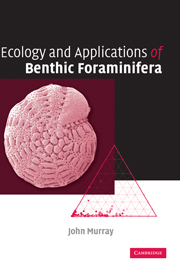Book contents
- Frontmatter
- Contents
- Preface
- 1 Introduction
- 2 Methods
- 3 Aspects of biology and basic ecology
- 4 Marginal marine environments
- 5 Shelf seas
- 6 Carbonate environments
- 7 Deep sea
- 8 Summary of living distributions
- 9 Taphonomic processes: formation of dead and fossil assemblages
- 10 Applications
- Glossary
- Appendix
- References
- Taxonomic Index
- General Index
9 - Taphonomic processes: formation of dead and fossil assemblages
Published online by Cambridge University Press: 12 August 2009
- Frontmatter
- Contents
- Preface
- 1 Introduction
- 2 Methods
- 3 Aspects of biology and basic ecology
- 4 Marginal marine environments
- 5 Shelf seas
- 6 Carbonate environments
- 7 Deep sea
- 8 Summary of living distributions
- 9 Taphonomic processes: formation of dead and fossil assemblages
- 10 Applications
- Glossary
- Appendix
- References
- Taxonomic Index
- General Index
Summary
Introduction
Fossil foraminifera are studied in order to reconstruct palaeoecological (including palaeoceanographic) conditions and for biostratigraphic correlation and dating. Subrecent foraminifera are used to investigate environmental change over the last few hundred years. In order to make these interpretations it is necessary to know whether the fossil record is representative of that originally living. Taphonomic processes are those that change the composition and preservation from living to dead to fossil assemblage. Living assemblages are transient, with temporal changes in absolute and relative abundance of species in relation to seasonal or longer variations in the environment. There are several stages in the transition from living assemblages to the fossil record:
Life processes that affect the contribution of tests to the sediment.
Postmortem processes that alter the proportions of species tests in the sediment over a period of decades to a few thousand years (depending on the rate of sediment accumulation) in the taphonomically active zone (TAZ) influenced by macrofaunal bioturbation.
Diagenetic effects that may further alter the faunal composition from the time they pass into the historical layer, i.e., below the TAZ.
Weathering effects at outcrop.
The aim of this chapter is to explore the consequences of these effects in order to determine how good a record is preserved. This knowledge is essential for the correct interpretation of past environmental conditions. Past reviews include those of Murray (1973; 1976a; 1991), Martin (Martin, 1999; Martin and Liddell, 1991) and Scott et al. (2001). For a theoretical approach to assemblage formation see Loubere et al. (1993).
Information
- Type
- Chapter
- Information
- Ecology and Applications of Benthic Foraminifera , pp. 265 - 280Publisher: Cambridge University PressPrint publication year: 2006
